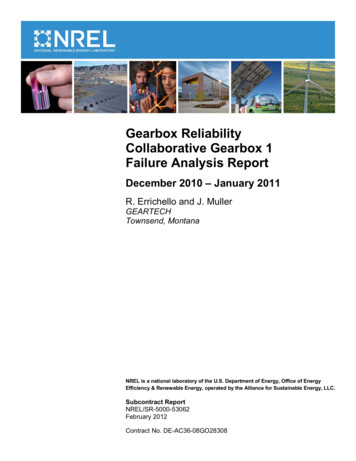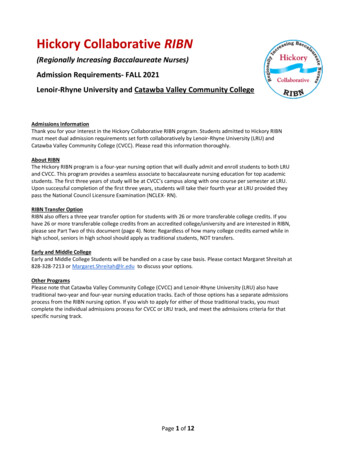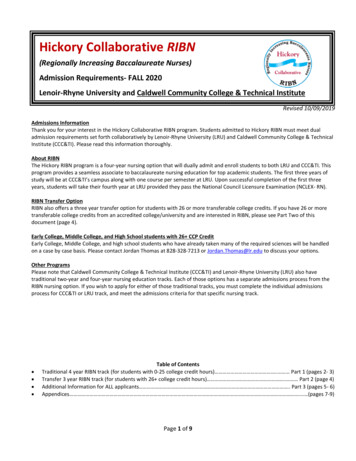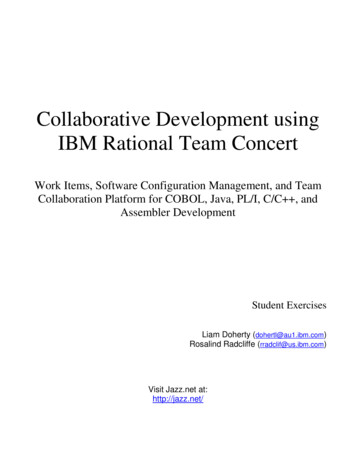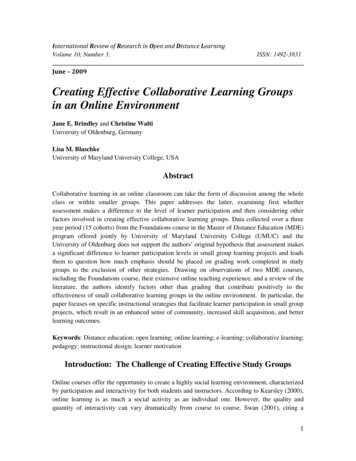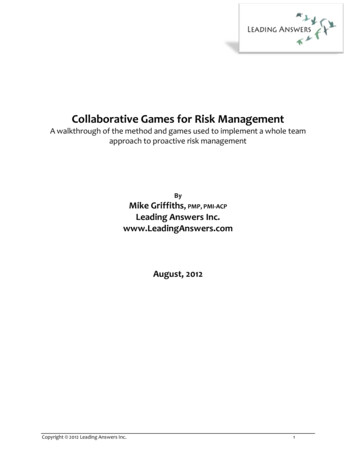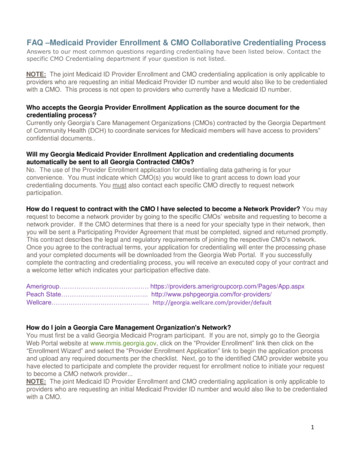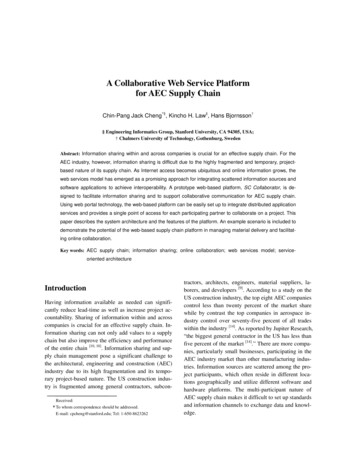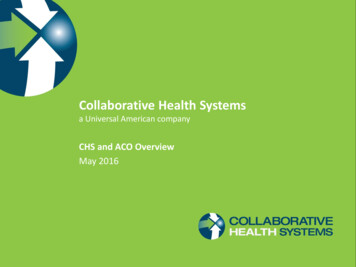
Transcription
Collaborative Health Systemsa Universal American companyCHS and ACO OverviewMay 2016
CHS Is the Largest Sponsor of MSSP ACOs Collaborative Health Systems (CHS) is a wholly-owned subsidiary of Universal American Corp. (NYSE:UAM), which, through its health maintenance organizations and health insurance companies, offers andadministers MA plans in Texas, New York, and Maine. CHS currently manages 22 MSSP ACOs, with more than 4,000 ACO providers, covering approximately337,000 assignable Medicare beneficiaries in 13 states. We are champions of the independent, primary care physician (PCP) Universal American is the largest sponsor of MSSP ACOs in the country and has invested over 100million in MSSP ACOs since the program’s inception in April 2012. Investments include: 2–Innovative population health information technology tools and analytics–Clinical care coordination and care management programs to help community-based physiciansdeliver high-value care.Our ACOs have generated savings to CMS of over 137 million for PY2012, PY2013, and PY2014combined.
22 ACOs in 10 StatesSoutheastWisconsinSyracuseMt KiscoHudsonChrysalis2Northern MDMD Collaborative CareMaryland Primary CareVA Collaborative CareNortheast GeorgiaMississippiNorth Texas4 Approved ACOs 4/1/12 .4 Approved ACOs – 7/1/12 .8 Approved ACOs – 1/1/13 2 Approved ACOs – 1/1/14 1 Approved ACO – 1/1/15 .2 Approved ACOs – 1/1/16 .1 Approved Next Generation ACO – 1/1/16 .Essential CarePartners4TexasNorthwestFloridaSoutheast TX(Next Generation)Coastal GeorgiaCentral GADeKalbGeorgiaWestern GA
Avenues to ValueOur ACOs Are Transitioning Up the Curve to Greater RiskBased Payment ArrangementsMSSPGrowth in MSSPACOs (numberand size)3 New ACOs in20164MSSP—RiskTracksMigrate ACOsinto NextGeneration andTracks 2/3MedicareAdvantage—UAMOfferingsConvert ACO FFSbeneficiaries intoUAM productofferingsMSO – MedicareAdvantage –Other PlansMSO support forother plancontractsTime1 Next Generation Successful MAand 6 in Track 2migrations in Syracuseand Mt. KiscoMSO – NonMedicareMSO support fornon-MA plancontracts (Medicaid,Exchange,Commercial)Engaging in conversations with majorMA plans in 2016
While CMS is Testing Many Models, MSSP is, by far, theLargest Initiative to Reduce the Rising Cost of Health CareEstimated Total Medicare FFS Spend Managed*, 2016MSSP ACOs 60 BillionAdvanced PrimaryCare Practice DemoPioneer ACOsBundledComprehensivePayments for CarePrimary CareImprovementAdvancedPayment ACO 10BCHS 5B 2.5B# ofBeneficiaries57.7M900K600k*Estimates based on total Medicare FFS expenditures of 445 Billion and number of Medicare beneficiaries enrolled in each model.Source: CMS, Lewin Group BPCI Analysis, CMMI, “Two Year Cost and Quality in the Comprehensive Primary Care Initiative,” NEJM. 4.9B150k 4B 3B400k300k
To Date, the MSSP Has Had Mixed SuccessSignificant Growth in ACOs andAttributed LivesMedicare ACOs404333Positive Quality Results and CMSRealized SavingsFinancial Results by MSSP ACO Cohorts434 220 2013201420152016Medicare Beneficiaries ReceivingCare from ACOs, Millions7.97.75.34.0 2013201420152016The first three years of theprogram can best be describedas a valuable learningexperience for all participantsIn PY 2013, MSSP ACOsimproved on 30 of 33 qualitymeasuresACOs that reported in bothperformance year two andthree showed improvement in27 out of the 33 qualitymeasures 315 million in shared savingsearned by 2012/13 MSSP ACOsand 341 million earned in2014Source: CMS.gov; ce-Payment/sharedsavingsprogram/index.html*Results based on 220 MSSP ACOs in 2012/2013 and 333 in 2014.6 However, Less Than 1/3 ofParticipants Earn Shared Savings*26%28%27%27%47%45%2012 and201420152013Earned Shared SavingsReduced SpendingNo Savings
CMS Proposed Several Changes to Improve MSSP in 2017In January, CMS released a proposed benchmarking rule for MSSP that would improve the benchmarkingmethodology by incorporating regional spending. We anticipate the rule will be released in June 2016.Proposed ChangeDetailed DescriptionIncorporate regional FFS expendituresinto the benchmarking methodology*Note: Only applies to second orsubsequent agreement period beginningon or after 1/1/17 Replace the national trend factor with a regional trend factor to rebase andupdate the benchmark annually. Gradually incorporate regional spending into the ACO’s benchmark. Remove the shared savings adjustment when rebasing the benchmark. Define region according to counties, weighted by the proportion of the ACO’sbeneficiaries in the county for all but ESRD beneficiaries. Use all beneficiaries eligible for ACO assignment (as opposed to all FFS) whendetermining regional expenditures Account for regional differences in risk-adjustment when adjusting the rebasedbenchmark.Facilitate transition to risk Add an option for Track One ACOs to extend for one year and defer moving toTrack Two or ThreeStreamline the methodology foradjusting an ACO’s benchmark when itscomposition changes Adjust an ACO’s historical benchmark for changes in participant compositionusing an expenditure ratio calculated for a single year (as opposed to the currentmethodology that recalculates based on three years)Refine criteria for reopening financialreconciliation decisions Set a four-year limit on reopening shared savings or losses determinations(contingent on good cause, such as new material evidence).Provide enhanced access to ACO data Publish new data files, including per capita county-level FFS spending an riskscores for 3 historical years .7Source: Proposed Changes to the Medicare Shared SavingsProgram Regulations.
In Addition, Next Generation ACO Model Offers StrongerFinancial Incentives and Tools to Create Systems of CareHigher Levels of Risk andReward 8Option of choosingbetween two riskarrangements—shared risk or full riskShared risk option:- First three years,ACOs savings/losseswill be 80%- During PYs 4 and 5,increases to 85%Full risk option:- ACO's share ofsavings/losses willbe 100%ACO's share of savingsand losses under bothoptions is capped at15% of benchmarkSource: CMS, Next Generation ACO Fact Sheet.Broader Range ofPayment Options Normal Fee-ForServiceFee-For-Service WithACO Support Payment:FFS rates plus anadditional PBPMpayment of up to 6PBPM which is repaidat the end of the PYPopulation BasedPayments: CMS willreimburse all claimssubmitted by ACOcontractedproviders/suppliers ata discounted rateCapitation: PBPMcapitation paymentImproved BenchmarkingMethodology Prospectively setbenchmark andbeneficiary attributionAnnual benchmarkrisk adjustments ( /3% corridor) using allcomponents of CMS'sHCC risk scores toadjust the benchmarkAn additional"discount" adjustmentto the benchmark toreflect the ACO'squality and efficiencyTools to Create InformalSystems of Care Ability for ACOs toselect preferredproviders who mayoffer benefitenhancements toattributedbeneficiariesEnhanced access tohome visits,telehealth, and SNFsReward payment tobeneficiaries forreceiving care fromthe ACOProcess that givesbeneficiaries adecision in theiralignment with ACOs
Factors Determining the Future of ACOs and AlternativePayment Models (APMs) 2015 MSSP ACO results will provide more data on the success of ACOsin terms of cost and quality. CMS is anticipated to release final 2015reconciliation reports in July/August 2016. MSSP final benchmarking rule will determine how many ACOs have aviable path to success under the structure of the program. As proposed,we are concerned that the rule puts ACOs that are higher cost relativeto their region at a perhaps insurmountable disadvantage. MACRA implementation will incent more physicians to move to twosided risk models; ACOs represent the most widespread vehicle toaccomplish this. CMMI alignment of value-based models: New APMs spun out of CMMI(e.g. Comprehensive Primary Care Plus) need be structured such thatthey ensure fair participation, rather than establishing competingmodels of care. New administration in the White House: Pending the results of thePresidential election, CMMI funding could be in jeopardy, underminingthe Next Generation ACO model and other APMs.9
Georgia Western GA 22 ACOs in 10 States . Our ACOs Are Transitioning Up the Curve to Gre
